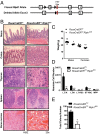Hematopoietic RIPK1 deficiency results in bone marrow failure caused by apoptosis and RIPK3-mediated necroptosis
- PMID: 25246544
- PMCID: PMC4209989
- DOI: 10.1073/pnas.1409389111
Hematopoietic RIPK1 deficiency results in bone marrow failure caused by apoptosis and RIPK3-mediated necroptosis
Abstract
Receptor-interacting serine/threonine-protein kinase 1 (RIPK1) is recruited to the TNF receptor 1 to mediate proinflammatory signaling and to regulate TNF-induced cell death. RIPK1 deficiency results in postnatal lethality, but precisely why Ripk1(-/-) mice die remains unclear. To identify the lineages and cell types that depend on RIPK1 for survival, we generated conditional Ripk1 mice. Tamoxifen administration to adult RosaCreER(T2)Ripk1(fl/fl) mice results in lethality caused by cell death in the intestinal and hematopoietic lineages. Similarly, Ripk1 deletion in cells of the hematopoietic lineage stimulates proinflammatory cytokine and chemokine production and hematopoietic cell death, resulting in bone marrow failure. The cell death reflected cell-intrinsic survival roles for RIPK1 in hematopoietic stem and progenitor cells, because Vav-iCre Ripk1(fl/fl) fetal liver cells failed to reconstitute hematopoiesis in lethally irradiated recipients. We demonstrate that RIPK3 deficiency partially rescues hematopoiesis in Vav-iCre Ripk1(fl/fl) mice, showing that RIPK1-deficient hematopoietic cells undergo RIPK3-mediated necroptosis. However, the Vav-iCre Ripk1(fl/fl) Ripk3(-/-) progenitors remain TNF sensitive in vitro and fail to repopulate irradiated mice. These genetic studies reveal that hematopoietic RIPK1 deficiency triggers both apoptotic and necroptotic death that is partially prevented by RIPK3 deficiency. Therefore, RIPK1 regulates hematopoiesis and prevents inflammation by suppressing RIPK3 activation.
Keywords: hematopoietic failure; programmed necrosis; tumor necrosis factor.
Conflict of interest statement
The authors declare no conflict of interest.
Figures





References
-
- Vanden Berghe T, Linkermann A, Jouan-Lanhouet S, Walczak H, Vandenabeele P. Regulated necrosis: the expanding network of non-apoptotic cell death pathways. Nat Rev Mol Cell Biol. 2014;15(2):135–147. - PubMed
-
- Lee TH, Shank J, Cusson N, Kelliher MA. The kinase activity of Rip1 is not required for tumor necrosis factor-alpha-induced IkappaB kinase or p38 MAP kinase activation or for the ubiquitination of Rip1 by Traf2. J Biol Chem. 2004;279(32):33185–33191. - PubMed
-
- Wertz IE, et al. De-ubiquitination and ubiquitin ligase domains of A20 downregulate NF-kappaB signalling. Nature. 2004;430(7000):694–699. - PubMed
Publication types
MeSH terms
Substances
Grants and funding
LinkOut - more resources
Full Text Sources
Other Literature Sources
Molecular Biology Databases
Miscellaneous

